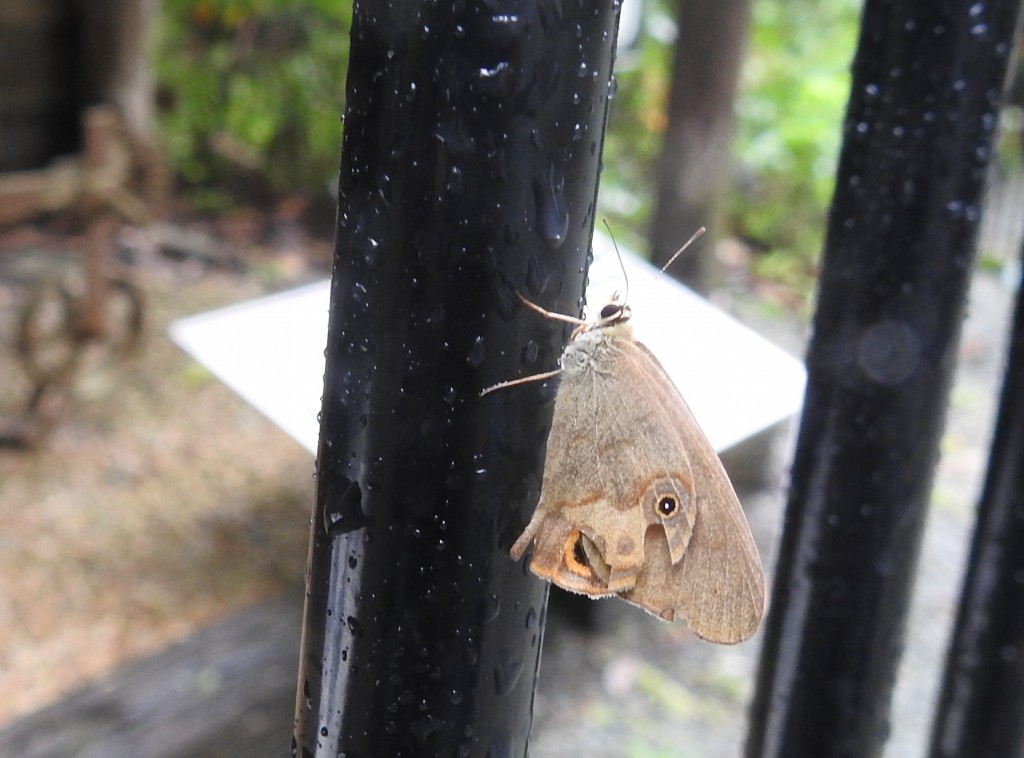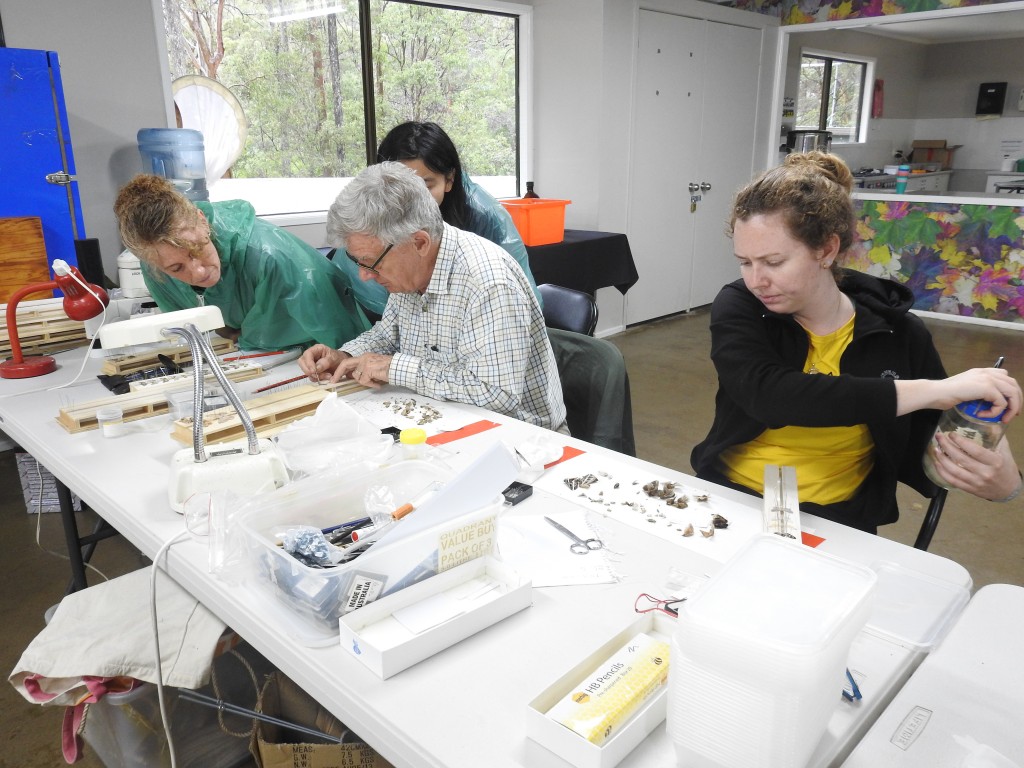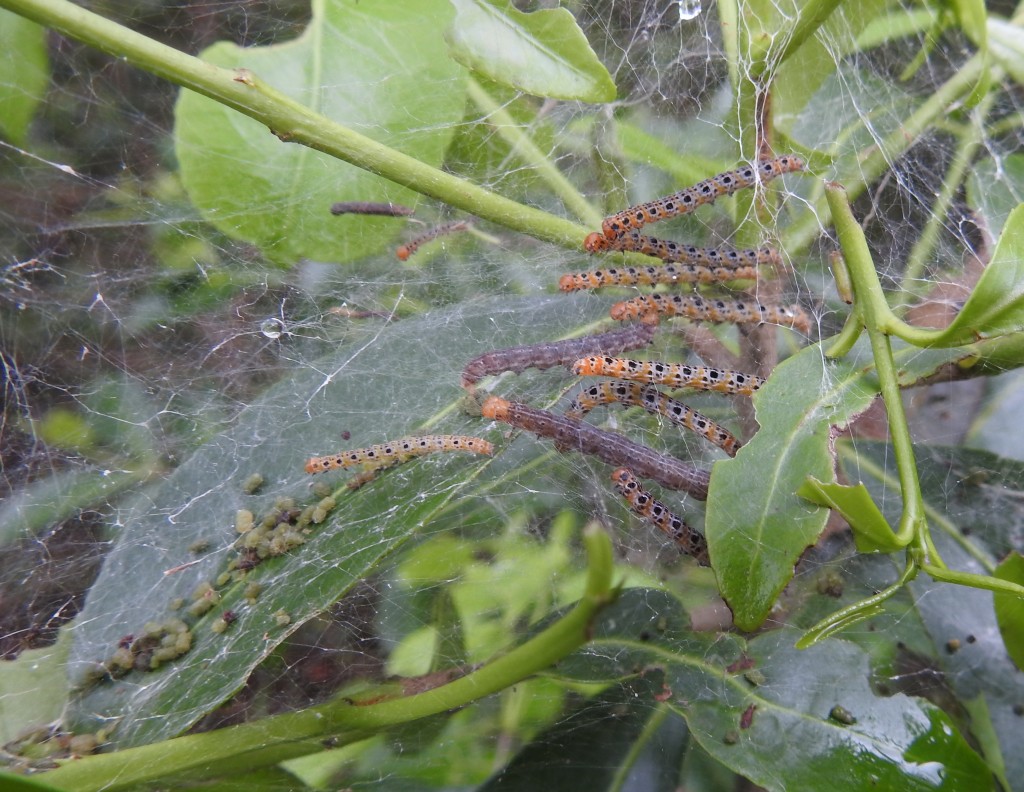Lepidoptera
(Moths and Butterflies)
Butterflies
Very few butterflies were seen, possibly due to the constant rain (moths on the other hand seem to like rain: see below)
Family Nymphalidae (family that includes common crow, blue tiger, the American monarch and many others)
- Ringlet (appears from the photo most similar to rock ringlet Hypocysta euphemia, but this is more commonly found in granite or sandstone country, and the common ringlet Hypocysta etirius may be more likely)
- Common Eggfly or Blue Moon Butterfly (Hypolimnas bolina) – Asher Nicholls, Siganto Street (about 10km south of Skywalk)
- Monarch Butterfly (Danaus plexippus) – Asher Nicholls, Siganto Street

Ringlet butterfly (Rock ringlet??), Nymphalidae, Skyewalk. Photo Ronda Green. Part of hindwing damaged, allowing a small section of the upper wing pattern to show through
Moths
There is such a multitude of moth species, some of them very small, and so many similar species, the only way to seriously explore what is present is to sample them and examine them under the microscope. Thus light traps were employed on each of three nights: the entry is too small to admit larger creatures although small beetles and other insects can also enter.
A large collection from the Bioblitz is currently in the process of sorting and identification, and preliminary results are presented below.
Prof. Roger Kitching, who led the moth-collecting team, notified us on 29th October that:
- 524 moths were sampled
- This included about 184 different spp.
- 63 ± were named to date.
- It is still a work in progress
Further progress, and a list of moths so far, were presented in late November (see below)
Roger has informed us that rainy evenings are excellent for moths. This came as a surprise to some, as butterflies seem to avoid flying in the rain.
The light traps were set in two habitats within the Thunderbird Park property: rainforest and sclerophyll (or open) forest dominated by eucalypts (“sclerophyll” means “hard leaf”, and “open” refers to the more open canopy as opposed to the rainforest, admitting more light). A greater diversity was collected from the sclerophyll forest, possibly because there were rainforest plants in the understory, providing habitat for caterpillars and adults relying on either rainforest or sclerophyll plants.
Summary of moths sorted and identified so far (26 November 2017).
All were collected from rainforest or sclerophyll forest (open forest, in this case dominated by eucalypts:”sclerophyll” means “hard leaf”)
Full details so far can be downloaded here as a 70kb pdf: Moths-Results-26-November-2017
We have now secured an additional grant from Scenic Rim Regional Council for Roger to give further training to a post-grad student and for that student to devote many hours into sorting and identifying as many as possible of the remaining moths. He and Roger will then publish papers in the entomological literature describing those hitherto unknown to science.
See below for a brief introduction to some of the families mentioned here *
Also scroll down for photos
| Family | Genus | Species | Open forest | Rain-forest |
| Anthelidae | Anthela | excellans | 1 | 0 |
| Crambidae | Palpita | limbata | 1 | 6 |
| Crambidae | Tetridia | caletoralis | 2 | 0 |
| Crambidae | Lygropia | quarternalis | 1 | 0 |
| Crambidae | Parotis | suralis | 2 | 1 |
| Crambidae | Merodictya | marmorata | 0 | 2 |
| Crambidae | 1 | 2 | ||
| Crambidae | Rehimena | infundibulalis | 0 | 3 |
| Crambidae | Maruca | vittata | 1 | 0 |
| Crambidae | Prooedema | incisuralis | 1 | 0 |
| Crambidae | Agrioglypta | excelsalis | 0 | 0 |
| Erebidae | Tigriodes | alterna | 4 | 2 |
| Erebidae | Hesychopa | chionora | 2 | 1 |
| Erebidae | Thallarcha | catasticta | 4 | 1 |
| Erebidae | Eilema | plana | 2 | 1 |
| Erebidae | Termessa | conographa | 6 | 2 |
| Erebidae | Termessa | gratiosa | 2 | 2 |
| Erebidae | Termessa | congrua | 4 | 0 |
| Erebidae | Amata | aperta | 7 | 4 |
| Erebidae | Grammodes | justa | 1 | 0 |
| Erebidae | Donuca | orbigera | 1 | 1 |
| Erebidae | Donuca | rubropicta | 11 | 11 |
| Erebidae | Pantydia | metaspila | 0 | 2 |
| Erebidae | Donuca | castalia | 2 | 0 |
| Erebidae | Parallelia | solomonensis | 1 | 0 |
| Erebidae | 0 | 3 | ||
| Erebidae | Laelia | sp. | 2 | 0 |
| Erebidae | 1 | 1 | ||
| Geometridae | Cleora | sp. 2 (Moths of Victoria) | 16 | 2 |
| Geometridae | Planolocha | sp. | 1 | 0 |
| Geometridae | Medasina | strixaria | 0 | 3 |
| Geometridae | Idiodes | sp. | 1 | 0 |
| Geometridae | Idiodes | sp. | 1 | 0 |
| Geometridae | Crypsiphona | ocultaria | 3 | 1 |
| Geometridae | Chlorocoma | sp. | 3 | 0 |
| Geometridae | Pingasa | cinerea | 0 | 1 |
| Geometridae | Hypobapta | barnardi | 1 | 0 |
| Geometridae | Argyrocosma | argosticta | 1 | 0 |
| Geometridae | Urolitha | bipunctifera | 0 | 1 |
| Geometridae | Sauris | lichenias | 7 | 0 |
| Geometridae | Epidesma | chilonaria | 2 | 2 |
| Geometridae | Nearcha | ursaria | 3 | 1 |
| Geometridae | Epidesma | perfabricata | 6 | 4 |
| Geometridae | Scopula | 4 | 1 | |
| Geometridae | 2 | 2 | ||
| Lasiocampidae | Cyclophragma | cyclomela | 1 | 1 |
| Lasiocampidae | Pinara | metaphaea | 1 | 0 |
| Limacodidae | Pseudanapaea | transvestita | 3 | 0 |
| Noctuidae | Zalissa | catocalina | 1 | 0 |
| Nolidae | Armactica | columbina | 1 | 0 |
| Notodontidae | Neola | semiaurata | 0 | 1 |
| Notodontidae | Sorama | bicolor | 1 | 3 |
| Notodontidae | Cascera | muscosa | 1 | 1 |
| Notodontidae | Omichlis | hadromeres | 0 | 2 |
| Notodontidae | Destomia | lineata | 5 | 0 |
| Notodontidae | Ochrogaster | lunifer | 53 | 23 |
| Notodontidae | Marane | melanospila | 1 | 0 |
| Oecophoridae | Eulechria | ?tolmera | 1 | 0 |
| Oecophoridae | Caroryctis | subparallela | 10 | 0 |
| Oecophoridae | Eulechria | sp. | 1 | 0 |
| Oecophoridae | Eulechria | pyrosalis | 2 | 0 |
| Pyralidae | Endotricha | chionocosma | 1 | 1 |
| Pyralidae | Endotricha | ignealis | 2 | 5 |
* Families of moths mentioned above:
- Anthelidae: a family found only in Australia and New Guinea, with large caterpillars, often very hairy
- Crambidae: grass moths, very variable, usually resting inconspicuously on grass stems
- Erebidae: one of the largest families of moths, very variable
- Geometridae: these include the famous “inch worms”, caterpillars that loop along as though they’re measuring a leaf.
- Lasiocampidae: snout moths, rather large hairy moths with long mouthparts looking like long noses
- Limacodidae: cup moths, the larvae are often beautiful to look at but have painful stinging hairs.
- Noctuidae: include some pests of crops
- Nolidae: caterpillars spin silk coccons
- Notodontidae: a mostly tropical family, usually large moths with long wings, caterpillars mostly smooth-bodied
- Oecophoridae: concealer moths (some caterpillars living between folded leaves or hollow twigs), a large family with its highest diversity in Australia and often associated with eucalyptus forests
- Pyralidae: a large family of small moths, some of which are also known as ‘snout moths’ or ‘grass moths’ (some older classifications combine the Pyralidae and Crambidae)








